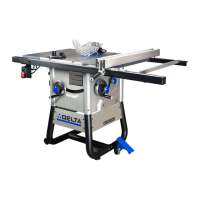20
In addition to reading these operating instructions, it is important to read and understand
the entire manual . Follow all applicable instructions regarding assembly, preparation, and
adjustment prior to making any cuts and comply with all safety rules and warnings in this section and elsewhere
throughout this manual.
• Are the power source and power connections
adequate for the saw?
• Are the saw and work area free of clutter and
by-standers?
• Is the blade tight and properly aligned?
• Does the riving knife thickness match the blade?
• Are the blade and riving knife properly aligned?
• Is the operator qualified to make the cut and familiar
with all of the relevant safety rules, warnings and
instructions included in this manual?
• Is the operator and everyone in proximity to the saw
wearing appropriate eye, hearing and respiratory
equipment?
• Are the bevel angle and height adjustment knobs
locked in the proper position?
• Is the blade set at the proper height?
• If ripping, is the rip fence parallel to the blade and
securely locked in position?
• If crosscutting, is the miter gauge knob tight?
• If making through cuts with a standard blade, are
the blade guard riving knife and anti-kickback pawls
properly attached and properly functioning with both
guards contacting the table surface?
• Is there proper clearance and support for the
workpiece as it leaves the blade?
• Are any cutting aids needed? If so, are they in place,
or within reach for proper use?
A kickback can occur when the workpiece pinches
the blade, or binds between the saw blade and the
rip fence or other fixed object. This can cause the
workpiece to rise from the table and/or be thrown back
toward the operator. See instructions for reducing the
risk of kickback on page 7 of this manual.
turn the saw "OFF" and verify
proper alignment of the blade, riving knife and miter
gauge or rip fence, and the proper functioning of the
riving knife, anti-kickback assembly and blade guard
assembly before resuming work.
A
B
The POWER switch (Figure 20) is located
underneath the front left extension wing.
1. To turn the saw "ON", pull the red paddle switch
(A) up and toward you.
2. To turn the saw "OFF", push the red paddle
switch in.
When not in use, the saw should be turned off and
the power switch locked out to prevent unauthorized
use. To lock out power switch, use a standard long
shackle lock, with a shackle that is at least 2 ¾ -
inches (70mm) long and with shackle posts no larger
than 9/32-inch (7mm) thick.

